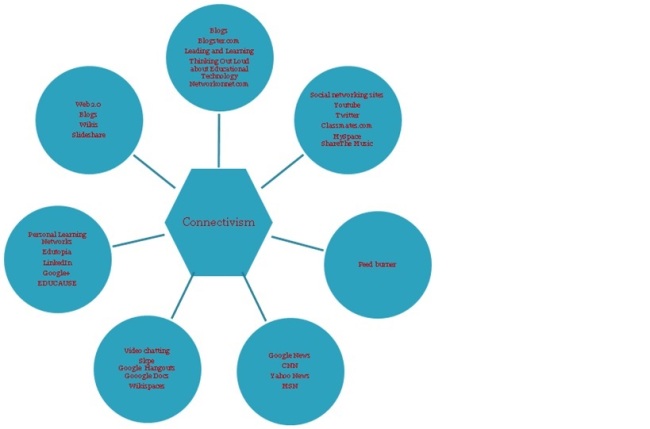Module 4 Connectivism
Here’s a look at my mind map on how I connect and what networks are changing the way they learn.
On a recent visit to my hometown in Atlanta, I sat in my parent’s living room with two of my nieces—one a psychologist, the other a marriage and family therapist—for a lively discussion on learning theories. Both with children under the age of five, we discussed, among other things, the developmental stages of Piaget. Although our opinions were different, we had a stimulating, entertaining, informative conversation. Thereafter, it occurred to me that my network has changed the way I learn. My face-to-face interactions with colleagues, other professionals, and educators—my old network—were almost nonexistent. Virtually replaced by the virtual world.
In that realm, the fragmented pieces of information I gather to generate, create new knowledge, integrate information from others—some similar, some different—all spark new questions and commentary. It is my new portal to learning, an ongoing learning process, much like dialogue, even after the blogs, wikis, and personal learning networks (plns) are closed. Siemens (2006) explained that knowledge acquisition is a learning process of several stages people often engage in before they actually come “to know” what it is they are seeking in order to complete or resolve an issue. I find myself engaging in exploration and inquiry in even greater amounts of time. The sheer instantaneous nature of connecting to these networks has changed the way I learn to an “I want it now” mentality. No longer is it necessary to “jot down” or remember the question and/or comment for next class’ discussion, department workshop or division meeting to acquire knowledge. My network to learning is readily available and infinite.
I’ve embraced the digital age for my own learning purposes. As such, the tools that help me to navigate, create, construct, and make meaning are as varied as the bits of information themselves. Constant and steady, however, are digital tools such as blogs, discussion forums, and articles that connect me to other colleagues’ ideas from around the globe, to provide me with intellectual exchange and collaboration. The social interaction these digital tools provide is a catalyst for my own learning. The ideas and theories become even clearer—from theory to practice—as colleagues share instructional design and classroom pedagogy in the digital age through technology such as YouTube, Slideshare, and Wikispaces.
These same tools, along with other digital tools such as Google Docs, allow me to collaborate with other colleagues, helping me to reflect on their interpretations and analyses. Brainstorming and developing collective ideas through Wikispaces, or gathering and evaluating research through online articles, all contribute to an understanding and to acquiring new knowledge when “what I know” or “think I know” is questionable. Siemens (2006) described this as “my personal network of trusted nodes: people and content, enhanced by technology.” I’ve come to learn that questions I may have, I can rely on this pipeline.
That’s my take, Linette
Check out this interesting blog urging teachers to change how they teach because students’ network has changed the way they learn.
Here’s a link to a YouTube video demonstrating hands-on usage of Google Docs as a digital tool to help students drive their own learning, collaborate and connect.
https://www.youtube.com/watch?v=h8u5JSNqzP8
References
Davidson, C. (2012, November 11). Teachers Should Change How They Teach Students Today. That’s Our Job: Response to NY
Times [Web log post] Retrieved from http://www.hastac.org/blogs/cathy-davidson/2012/11/01/teachers-should-change-how-
they-teach-students-today-thats-our-job-r
EasyBibVideos. (2013, August 14). Using Google Docs for 21st Century Learning. Retrieved from
Siemens, G. (2006). Knowing knowledge. Retrieved from http://www.Lulu.com

Hi Linette,
I enjoyed reading your blog and agree with your statement “No longer is it necessary to “jot down” or remember the question and/or comment for next class’ discussion, department workshop or division meeting to acquire knowledge. My network to learning is readily available and infinite”. How do you use your network to supplement writing a note or questions regarding questions or comments for the next class or meeting?
Sarah
Sarah for the most part, I use discussion forums to supplement the need for writing a note or asking a question.
Hi Linette,
Your Blog entry made me realize that I too have moved much of myself into cyberspace. What is funny is that is was a gradual slide from one reality, face-to-face, into the other, virtual. I have to monitor myself. My tendency is to process and network differently from a computer than I do in a face-to-face setting. Face-to-face I have noticed I have a casual approach but snap into a different, more professional, mindset when I am learning, working, processing, or networking online. Until I read about your experience I had not really thought about this difference in myself but I do notice it in others, especially those learners with whom I interact. Thank you for the gentle reminder that I must constantly reflect and look inward if I am to be an effective course facilitator.
Warm Regards,
Shelly